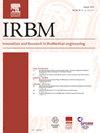Complementary Split-Ring Resonator for Non-Invasive Diagnosis of Carotid Artery Atherosclerosis: Towards Future in-Vivo Measurements
IF 5.6
4区 医学
Q1 ENGINEERING, BIOMEDICAL
引用次数: 0
Abstract
Objectives
The limited penetration depth of electromagnetic (EM) waves into biological tissues is a significant challenge for the use of microwave sensors in medical diagnostics. This study proposes a sensor based on a complementary split-ring resonator (CSRR) for the non-invasive detection of carotid atherosclerotic plaques, designed to be placed on the patient's neck.
Material and methods
The sensor employs a widened feed line and an optimized sensing area to concentrate the electric field and store a significant amount of energy within the biological tissue. Validation includes EM simulations and ex-vivo measurements on fresh animal tissues using monolayer and multilayer configurations to simulate human neck anatomy. A three-dimensional carotid artery model is also introduced to extend the analysis to deeper tissue layers and simulate different degrees of stenosis between 25% and 75%.
Results
The sensor demonstrates a sensitivity of 0.72% and a detection resolution of 14 MHz for a dielectric constant range from 1 to 52 in material measurements, which has contributed to enhancing the EM penetration depth in neck tissues. Simulation results for atherosclerotic plaques in the carotid artery revealed a frequency shift difference induced by stable and vulnerable plaques of around 1 to 2 MHz.
Conclusion
These findings highlight the sensor's potential for future use in the in- vivo diagnosis of carotid artery atherosclerosis.

用于颈动脉粥样硬化无创诊断的互补裂环谐振器:走向未来的体内测量
目的电磁(EM)波对生物组织的穿透深度有限是微波传感器在医学诊断中应用的一个重大挑战。本研究提出了一种基于互补裂环谐振器(CSRR)的传感器,用于无创检测颈动脉粥样硬化斑块,设计用于患者颈部。材料和方法该传感器采用加宽的馈线和优化的传感区域来集中电场并在生物组织内存储大量能量。验证包括EM模拟和新鲜动物组织的离体测量,使用单层和多层配置来模拟人体颈部解剖。还引入了三维颈动脉模型,将分析扩展到更深的组织层,并模拟25%至75%之间不同程度的狭窄。结果该传感器在介电常数1 ~ 52范围内的材料测量灵敏度为0.72%,检测分辨率为14 MHz,有助于提高颈部组织的电磁穿透深度。对颈动脉粥样硬化斑块的模拟结果显示,稳定斑块和易损斑块引起的频移差异约为1至2 MHz。结论该传感器在颈动脉粥样硬化的体内诊断中具有广阔的应用前景。
本文章由计算机程序翻译,如有差异,请以英文原文为准。
求助全文
约1分钟内获得全文
求助全文
来源期刊

Irbm
ENGINEERING, BIOMEDICAL-
CiteScore
10.30
自引率
4.20%
发文量
81
审稿时长
57 days
期刊介绍:
IRBM is the journal of the AGBM (Alliance for engineering in Biology an Medicine / Alliance pour le génie biologique et médical) and the SFGBM (BioMedical Engineering French Society / Société française de génie biologique médical) and the AFIB (French Association of Biomedical Engineers / Association française des ingénieurs biomédicaux).
As a vehicle of information and knowledge in the field of biomedical technologies, IRBM is devoted to fundamental as well as clinical research. Biomedical engineering and use of new technologies are the cornerstones of IRBM, providing authors and users with the latest information. Its six issues per year propose reviews (state-of-the-art and current knowledge), original articles directed at fundamental research and articles focusing on biomedical engineering. All articles are submitted to peer reviewers acting as guarantors for IRBM''s scientific and medical content. The field covered by IRBM includes all the discipline of Biomedical engineering. Thereby, the type of papers published include those that cover the technological and methodological development in:
-Physiological and Biological Signal processing (EEG, MEG, ECG…)-
Medical Image processing-
Biomechanics-
Biomaterials-
Medical Physics-
Biophysics-
Physiological and Biological Sensors-
Information technologies in healthcare-
Disability research-
Computational physiology-
…
 求助内容:
求助内容: 应助结果提醒方式:
应助结果提醒方式:


